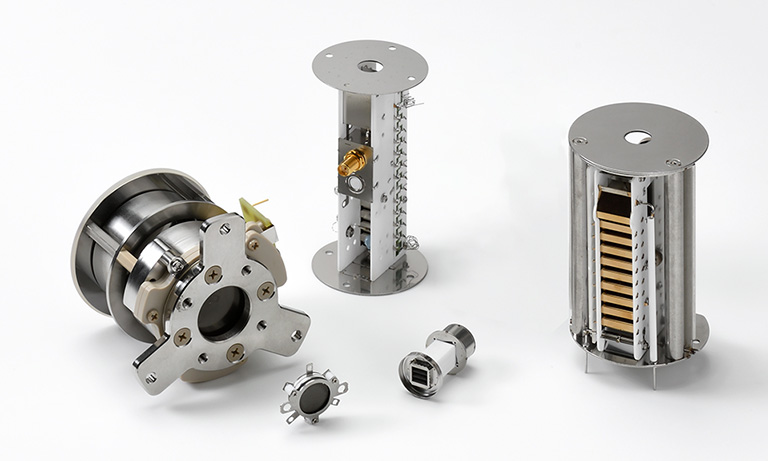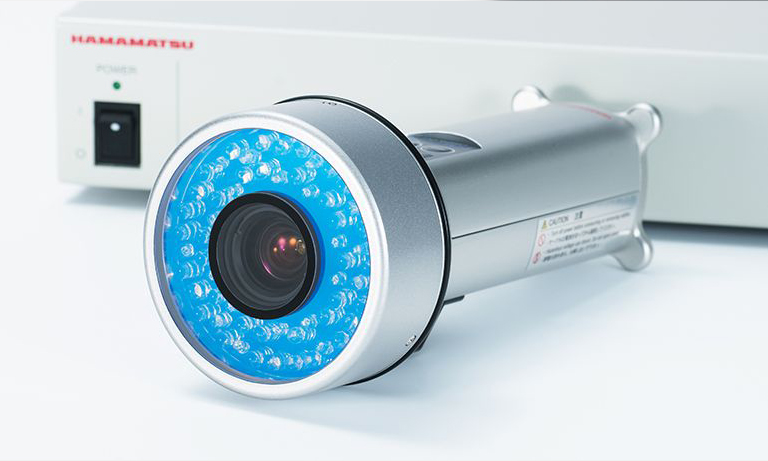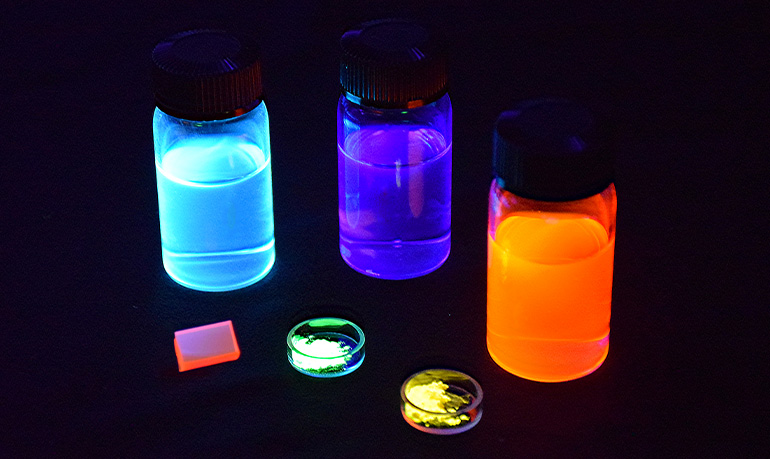Japan (EN)
Select your region or country.


Quantum technology
Emerging technologies such as quantum computing and quantum simulation are realized by manipulating and controlling the unique properties and behaviors of quanta (atoms, electrons, photons, etc.) such as duality, superposition, and entanglement.
Bose–Einstein condensation (BEC)
Laser cooling is a technique developed in the late 1980s that utilizes lasers to cool or trap gas atoms. In 1995, laser cooling contributed to the realization of Bose-Einstein condensation (BEC) produced in a vapor of rubidium-87 atoms. Laser cooling and BEC enabled observation of the quantum mechanical behavior of single atoms and ions.
Recomended products
The ORCA-Quest is capable of photon number resolving, and can detect atomic luminescence quantitatively, rapidly, and with high resolution.
The ORCA-Fusion BT digital CMOS camera can detect atomic emission at high speed and high resolution.
Quantum imaging
Quantum imaging is an imaging technique that utilizes quantum characteristics of light to realize highly sensitive or special imaging methods. One of these methods known as “ghost imaging” acquires images of entanglement by detecting correlated entangled photons. Ghost imaging has captured researchers’ interest in recent years.

Recommended products
The ORCA-Quest is capable of photon number resolving, which creates new possibilities for quantum imaging as well as quantum entanglement phenomena.
The LCOS-SLM is a reflective spatial light modulator that freely controls the phase of light with a liquid crystal. Precise wavefront control enables the generation of higher-order Laguerre-Gaussian beams.
The HPD is a photodetector that can detect photons with high sensitivity, fast response, and low jitter. HPDs maximize detection efficiency and have lower excess noise than PMTs, resulting in better signal-to-noise ratio than PMTs.
Neutral atoms and trapped ions
Neutral atoms and trapped ions use laser cooling to cool down the atoms or ions, which in turn slows down their motion. Optical tweezers are used to trap neutral atoms while traps such as Penning traps or Paul traps utilize electric fields to create potentials that confine ions. A large number of beam spots can be generated by combining the spatial light phase modulator (LCOS-SLM) with an appropriate phase pattern and optical system. Trapping neutral atoms at those spot positions allows neutral atoms to be arranged in any array configuration. Neutral atoms and trapped ions can be configured in a "superposition state," which means that their state is encoded using both the “0” state and “1” state also known as a qubit. Trapped ions’ and neutral atoms’ positions are monitored using a high-sensitivity camera. Observing the fluorescence, or lack thereof, for trapped ions and neutral atoms indicates the state of the qubit. Photon counting detectors such as PMTs are typically used for reading out the qubit state of trapped ions while EM-CCD cameras are used for reading out the qubit state of neutral atoms. Quantum mechanical behavior can be manipulated to realize applications such as quantum computing and quantum simulations.


Recomended products
The ORCA-Quest is capable of photon number resolving, which enables quantitative detection of weak light from trapped ions and neutral atoms while maintaining high resolution.
The ORCA-Fusion BT enables the detection of weak light from trapped ions and neutral atoms with high speed and resolution.
The LCOS-SLM is a reflective spatial light modulator that freely controls the phase of light with a liquid crystal. Controlling the phase (wavefront) with LCOS-SLM enables researchers to generate a highly efficient optical microtrap array.
The photon counting head H10682 series is a module that enables photon counting measurement of ion fluorescence with high sensitivity and low noise.
The 32-channel linear array multianode PMT module H11460 series is a low crosstalk module that can detect fluorescence of multiple ions with a 32-channel linear array. (The photon counting module H12211 is also available.)
The HPD is a photodetector that can detect fluorescence with high sensitivity, fast response, and low jitter. HPDs maximize quantum efficiency and have lower excess noise than PMTs, resulting in better signal-to-noise ratio than PMTs.
Nitrogen vacancy (NV)
Diamond is a carbon crystal. If you remove a carbon atom in the crystal lattice and replace it with a nitrogen atom, this results in the creation of electron vacancies, hence the term “nitrogen vacancy.” Nitrogen-vacancy (NV) centers have the property of reacting very sensitively to changes in the surrounding environment and to changes in the quantum state, and this property can be used as a sensor function. For this reason, a diamond with an NV center is counted as a "quantum sensor" and is attracting attention as a next-generation ultra-sensitive sensor. Nitrogen vacancy is an attractive qubit modality for quantum computation and quantum simulation since it has the ability to operate at room temperature.

Recomended products
ORCA-Quest is capable of Photon number resolving, which enables quantitative detection of weak fluorescence from NV centers while maintaining high resolution.
The ORCA-Fusion BT enables highly sensitive and fast detection of weak fluorescence from NV centers.
The LCOS-SLM is a reflective spatial light modulator that freely controls the phase of light with a liquid crystal. Precise wave-front control enables simultaneous multi-point irradiation.
MPPC features high gain (about 106), high photon detection efficiency for detecting 650nm NV fluorescence, wide dynamic range, and excellent photon peak value discrimination ability, so it can obtain high S/N for high-speed, weak signals. MPPC modules are available which incorporate the MPPC, amplifier, and power supply which makes them easy to use.
Case study
Utako Tanaka Group of Graduate School of Engineering Science, The University of Osaka is conducting research on the "ion trap" method - one of the architectures for quantum computing - and developing technologies to implement it on-chip. To image individual ions suspended in a vacuum, the group has adopted the ORCA-Quest camera. We interviewed Professor Utako Tanaka, who leads the group, and Mr. Ryosuke Nishimoto, who is in charge of the experiments, to learn more about the background behind the adoption of ORCA-Quest and their future research outlook.
To reach a large-scale general-purpose quantum computer, several approaches are being proposed (e.g., superconducting qubit, trapped ion qubit), but it has yet to be decided which one is the winner. A scientific camera is commonly used in a quantum computer with neutral atom, one of the most promising qubits. We interviewed Professor Takashi Yamamoto and Associate Professor Toshiki Kobayashi of The University of Osaka, who are using ORCA-Quest for neutral atom quantum computing.
ORCA-Quest qCMOS camera from Hamamatsu was chosen as a camera for mid-circuit imaging in an error-corrected neutral-atom quantum computer. The experiments was led by Harvard university in close collaboration with QuEra Computing, MIT, and NIST/UMD.
- Confirmation
-
It looks like you're in the . If this is not your location, please select the correct region or country below.
You're headed to Hamamatsu Photonics website for JP (English). If you want to view an other country's site, the optimized information will be provided by selecting options below.
In order to use this website comfortably, we use cookies. For cookie details please see our cookie policy.
- Cookie Policy
-
This website or its third-party tools use cookies, which are necessary to its functioning and required to achieve the purposes illustrated in this cookie policy. By closing the cookie warning banner, scrolling the page, clicking a link or continuing to browse otherwise, you agree to the use of cookies.
Hamamatsu uses cookies in order to enhance your experience on our website and ensure that our website functions.
You can visit this page at any time to learn more about cookies, get the most up to date information on how we use cookies and manage your cookie settings. We will not use cookies for any purpose other than the ones stated, but please note that we reserve the right to update our cookies.
1. What are cookies?
For modern websites to work according to visitor’s expectations, they need to collect certain basic information about visitors. To do this, a site will create small text files which are placed on visitor’s devices (computer or mobile) - these files are known as cookies when you access a website. Cookies are used in order to make websites function and work efficiently. Cookies are uniquely assigned to each visitor and can only be read by a web server in the domain that issued the cookie to the visitor. Cookies cannot be used to run programs or deliver viruses to a visitor’s device.
Cookies do various jobs which make the visitor’s experience of the internet much smoother and more interactive. For instance, cookies are used to remember the visitor’s preferences on sites they visit often, to remember language preference and to help navigate between pages more efficiently. Much, though not all, of the data collected is anonymous, though some of it is designed to detect browsing patterns and approximate geographical location to improve the visitor experience.
Certain type of cookies may require the data subject’s consent before storing them on the computer.
2. What are the different types of cookies?
This website uses two types of cookies:
- First party cookies. For our website, the first party cookies are controlled and maintained by Hamamatsu. No other parties have access to these cookies.
- Third party cookies. These cookies are implemented by organizations outside Hamamatsu. We do not have access to the data in these cookies, but we use these cookies to improve the overall website experience.
3. How do we use cookies?
This website uses cookies for following purposes:
- Certain cookies are necessary for our website to function. These are strictly necessary cookies and are required to enable website access, support navigation or provide relevant content. These cookies direct you to the correct region or country, and support security and ecommerce. Strictly necessary cookies also enforce your privacy preferences. Without these strictly necessary cookies, much of our website will not function.
- Analytics cookies are used to track website usage. This data enables us to improve our website usability, performance and website administration. In our analytics cookies, we do not store any personal identifying information.
- Functionality cookies. These are used to recognize you when you return to our website. This enables us to personalize our content for you, greet you by name and remember your preferences (for example, your choice of language or region).
- These cookies record your visit to our website, the pages you have visited and the links you have followed. We will use this information to make our website and the advertising displayed on it more relevant to your interests. We may also share this information with third parties for this purpose.
Cookies help us help you. Through the use of cookies, we learn what is important to our visitors and we develop and enhance website content and functionality to support your experience. Much of our website can be accessed if cookies are disabled, however certain website functions may not work. And, we believe your current and future visits will be enhanced if cookies are enabled.
4. Which cookies do we use?
There are two ways to manage cookie preferences.
- You can set your cookie preferences on your device or in your browser.
- You can set your cookie preferences at the website level.
If you don’t want to receive cookies, you can modify your browser so that it notifies you when cookies are sent to it or you can refuse cookies altogether. You can also delete cookies that have already been set.
If you wish to restrict or block web browser cookies which are set on your device then you can do this through your browser settings; the Help function within your browser should tell you how. Alternatively, you may wish to visit www.aboutcookies.org, which contains comprehensive information on how to do this on a wide variety of desktop browsers.
5. What are Internet tags and how do we use them with cookies?
Occasionally, we may use internet tags (also known as action tags, single-pixel GIFs, clear GIFs, invisible GIFs and 1-by-1 GIFs) at this site and may deploy these tags/cookies through a third-party advertising partner or a web analytical service partner which may be located and store the respective information (including your IP-address) in a foreign country. These tags/cookies are placed on both online advertisements that bring users to this site and on different pages of this site. We use this technology to measure the visitors' responses to our sites and the effectiveness of our advertising campaigns (including how many times a page is opened and which information is consulted) as well as to evaluate your use of this website. The third-party partner or the web analytical service partner may be able to collect data about visitors to our and other sites because of these internet tags/cookies, may compose reports regarding the website’s activity for us and may provide further services which are related to the use of the website and the internet. They may provide such information to other parties if there is a legal requirement that they do so, or if they hire the other parties to process information on their behalf.
If you would like more information about web tags and cookies associated with on-line advertising or to opt-out of third-party collection of this information, please visit the Network Advertising Initiative website http://www.networkadvertising.org.
6. Analytics and Advertisement Cookies
We use third-party cookies (such as Google Analytics) to track visitors on our website, to get reports about how visitors use the website and to inform, optimize and serve ads based on someone's past visits to our website.
You may opt-out of Google Analytics cookies by the websites provided by Google:
https://tools.google.com/dlpage/gaoptout?hl=en
As provided in this Privacy Policy (Article 5), you can learn more about opt-out cookies by the website provided by Network Advertising Initiative:
http://www.networkadvertising.org
We inform you that in such case you will not be able to wholly use all functions of our website.
Close
























































































































